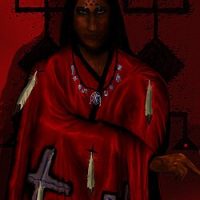Iktomi : The Trickster Spirit
Listen
At a glance
| Description | |
|---|---|
| Origin | Lakota Mythology |
| Classification | Spirits |
| Family Members | Inyan (Father) |
| Region | United States of America |
| Associated With | Mischief, Trickster |
Iktomi
Introduction
Iktomi is one of the most captivating figures in Lakota mythology, remembered as both a spider-trickster and a cultural hero. His tales embody humor, mischief, wisdom, and contradiction, making him a figure of fascination across Native American storytelling traditions. Iktomi is not only a character who amuses with pranks but also a symbol of the duality of human nature—capable of both creation and destruction, enlightenment and folly. The Lakota people used his stories to teach children about morality, respect for others, and the dangers of arrogance. Over generations, Iktomi’s legends have grown into a cornerstone of Plains mythology, extending his influence well beyond the Lakota and Dakota to wider Native American oral traditions.
Physical Traits
In Lakota tradition, Iktomi most often appears as a spider, a creature that symbolizes weaving, connection, and cunning entrapment. This form represents his ability to spin elaborate schemes, much like a spider spins a web. However, he is also known for his shapeshifting ability, frequently adopting human form. When he becomes a man, Iktomi is usually described as thin-limbed, with striking facial markings. His face is often painted in bright colors such as red, yellow, and white, contrasted with black circles around his eyes to emphasize his trickster nature. He is also associated with animal clothing, wearing raccoon and buckskin garments that highlight his connection to the natural and spiritual worlds. The fluidity of his appearance reflects his supernatural power and his role as a liminal being who moves between the human and spirit realms.
Family
The origins of Iktomi lie deep in Lakota cosmology. He is described as the firstborn son of Inyan, the primordial Rock spirit, who represents stability and creation. Some traditions suggest that Iktomi was originally named Ksa, the personification of wisdom. However, through arrogance and misuse of his knowledge, he was transformed into Iktomi—a fallen version of his former self. This story emphasizes how wisdom can become corrupted when used for selfish purposes, turning insight into cunning. Certain versions of Lakota myth link him with other powerful spirits, including Unk, the spirit of passion, and Gnaski, a demon of confusion, further portraying him as a figure born out of cosmic tension. His family ties underline the idea that Iktomi carries divine origins, yet his behavior distances him from the order of creation, setting him apart as both insider and outsider in the mythological hierarchy.
Other names
Across Indigenous communities, Iktomi is known by several names that reflect regional and linguistic differences. Among the Lakota, he is most commonly called Iktomi, which directly translates to “spider.” In Dakota stories, he is sometimes known as Inktomi or Unktomi, while other Sioux traditions refer to him as Ikto or Ictinike. These variations show the widespread recognition of his character across the Great Plains. Despite the differences in pronunciation or spelling, all of these names highlight his essential spider-like qualities—entanglement, trickery, and control. The fact that Iktomi’s tales exist under so many names suggests not only the cultural importance of his stories but also their adaptability, as each community shaped the figure of Iktomi to fit its own teachings and values.
Powers and Abilities
Iktomi’s most distinctive powers stem from his role as a trickster. He has the ability to manipulate others through deception, creating elaborate schemes that often reveal the weaknesses of those around him. A master shapeshifter, he can transform between spider and human, and in some stories, he even takes on the forms of other animals or spirits to deceive his targets. He is said to possess foresight, giving him knowledge of future events, though his arrogance often leads him to misuse it.
Another striking ability associated with Iktomi is his use of strings, which he employs to control people like puppets. This reflects his larger power to entangle others in webs of lies or illusions. At times, Iktomi is depicted as a teacher of sacred rituals or as a bringer of new skills to the Lakota, such as language, storytelling, and even technologies. Some modern interpretations link him to the concept of the web in communication, drawing a parallel between his spider webs and the modern internet. Yet, while he can provide valuable knowledge, his tricks often end in disaster for himself, serving as cautionary tales about the dangers of greed, dishonesty, and overconfidence.
Modern Day Influence
Despite his ancient origins, Iktomi remains an important figure in the cultural imagination of the Lakota and other Native American groups. His stories are still told in educational settings to impart lessons about honesty, humility, and self-control. Museums and cultural centers, such as the Akta Lakota Museum, often feature him as part of exhibits that highlight Lakota spirituality and folklore.
In contemporary literature and art, Iktomi has been reinterpreted as a symbol of survival and adaptability. His trickster qualities resonate with Indigenous communities who have endured the pressures of colonization and cultural assimilation, turning resilience into a form of resistance. In popular culture, Iktomi has made appearances in novels, comic books, and even television series. Neil Gaiman’s American Gods adaptation, for example, references him, blending traditional myth with modern storytelling.
Iktomi’s spider symbolism has also been reimagined in the context of digital life. His web is compared to the internet, telephone systems, and communication networks, making him a contemporary metaphor for connection and entanglement in the modern world. For Indigenous authors and educators, his stories are a way to preserve heritage while simultaneously addressing modern challenges, ensuring that his legacy continues to inspire reflection on the balance between wisdom and folly.
Its legend continues to shape Southern African folklore, acting as a cautionary tale about the perils of wandering alone at night. The creature’s fearsome image has also found its way into various artistic and literary works, keeping its myth alive in modern storytelling and cultural discourse.
Related Images
Source
Bonnin, G. S. (1901). Old Indian Legends. Ginn and Company.
Fletcher, R. (2024). Iktomi Tales. World History Encyclopedia. https://www.worldhistory.org/article/2443/iktomi-tales/
Hakuta, K. (2025). Iktómi the Trickster in Lakota Legends. Aktalakota. https://aktalakota.stjo.org/lakota-legends/iktomi-the-trickster/
Harvey, A. (2025). Lakota Mythology. Wikipedia. https://en.wikipedia.org/wiki/Lakota_mythology
Johnson, M. (2006). Iktomi (Lakota Trickster Spirit). Marvunapp. http://www.marvunapp.com/Appendix3/iktomidwd.htm
Kehoe, A. B. (2002). The Ghost Dance: Ethnohistory and Revitalization. University of California Press.
Walker, J. (n.d.). Lakota Spirituality and Myths: The Web of Wisdom and Folly. Tribal Publishing.
Wheeler, L. (2025). Native American Tricksters: Cultural Heroes and Clowns. Journal of Indigenous Studies, 35(1), 45-63.
Frequently Asked Questions
What is lorem Ipsum?
I am text block. Click edit button to change this text. Lorem ipsum dolor sit amet, consectetur adipiscing elit. Ut elit tellus, luctus nec ullamcorper mattis, pulvinar dapibus leo.
What is lorem Ipsum?
I am text block. Click edit button to change this text. Lorem ipsum dolor sit amet, consectetur adipiscing elit. Ut elit tellus, luctus nec ullamcorper mattis, pulvinar dapibus leo.
What is lorem Ipsum?
I am text block. Click edit button to change this text. Lorem ipsum dolor sit amet, consectetur adipiscing elit. Ut elit tellus, luctus nec ullamcorper mattis, pulvinar dapibus leo.
What is lorem Ipsum?
I am text block. Click edit button to change this text. Lorem ipsum dolor sit amet, consectetur adipiscing elit. Ut elit tellus, luctus nec ullamcorper mattis, pulvinar dapibus leo.
What is lorem Ipsum?
I am text block. Click edit button to change this text. Lorem ipsum dolor sit amet, consectetur adipiscing elit. Ut elit tellus, luctus nec ullamcorper mattis, pulvinar dapibus leo.









